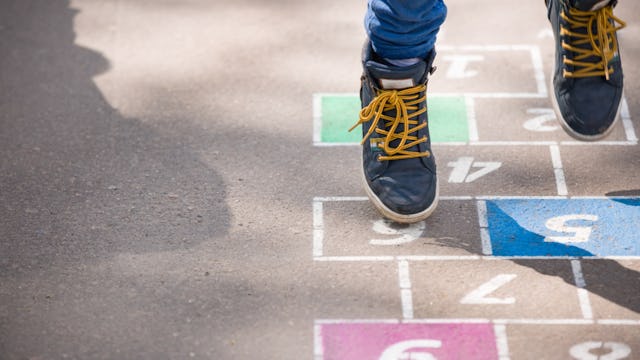Stop Taking Away Recess

We all know recess is important for kids. Teachers know it. Parents know it. Kids definitely know it. And we need to stop taking away recess, full stop.
Your American elementary school kid probably gets about 25 minutes of recess per day. Half of that recess time is structured, meaning the activities are planned by an adult. 97% of teachers say recess improves student performance and was especially important for kids who “tended to behave badly.”
Yet 86% admitted to taking away recess as a consequence for that same behavior. And 7% of schools had no recess at all. This all according to a study by the International Play Equipment Manufacturer’s Association and its Voice of Play initiative, which surveyed 500 randomly selected US teachers.
Just how important is recess? Well, one Texas school district found out when it changed to a whopping 1 hour of recess daily, broken into 15-minute increments throughout the day: 2 in the morning and 2 in the afternoon. The kids go outside even when it’s cold and even when it’s wet. The key, psychologists told TODAY, is outdoor, unstructured play: play not planned or mitigated by adults, but when kids are allowed to “run, play, and make up their own games.”
With four recess breaks, teachers in the Texas school district report that kids are “less fidgety and more focused,” that they “listen more attentively, follow directions, and try to solve problems on their own instead of coming to the teacher to fix everything.” The school has also had fewer discipline issues.
The Atlantic notes that when 10,000 third-grade teachers were asked to fill out questionnaires, even just one 15-minute recess correlated with better classroom behavior. Just 15 minutes.
Recess isn’t a waste of time, like many might think — time kids could spend, instead, cramming for the endless parade of standardized tests they’re now subject to. The American Academy of Pediatrics said in a 2013 policy statement, “Recess is a crucial and necessary component of a child’s development and, as such, it should not be withheld for punitive or academic reasons.”
Recess is also “a complement to, but not a substitute for, physical education … only recess (particularly unstructured recess) provides the creative, social, and emotional benefits of play.”
Recess isn’t just a lot of running around and yelling, like it might look to outsiders. There is, instead, a lot of complex play and negotiation going on. Recess is where kids practice social skills and role-play with peers after a day spent being told “no talking,” and “sit still,” and “eye forward, please,” according to Peaceful Playgrounds.
Kids learn “negotiation, cooperation, sharing, problem-solving, and coping skills, such as perseverance and self-control.” They manage and process stress from the school day. And, for those of you out there concerned about test scores, it gives them a chance to recharge and emerge more ready to learn. In fact, many countries with strong education systems prioritize recess. For instance, Finland offers recess once an hour.
We also like to push healthy eating programs and brainstorm ways to get kids off the couch — then turn around and cut their recess time. Peaceful Playgrounds cites a CDC position paper that reminds us recess contributes to the recommended hour of active time kids are supposed to get every single day, and “helps reduce in sedentary behaviors with TV, computers, and video games.” Think kids are just standing around? Think again: studies have found that both boys and girls spend “the majority of their recess time engaged in physical activity.”
Which not only helps their bodies, but also their brains. A 2010 CDC report found that recess had a positive influence on academic achievement. Time Magazine also cites a 2016 study that says the more time boys spent sitting, the slower they progressed in both reading and math. According to Peaceful Playgrounds, “Recess contributes to optimal cognitive processing and a break from academic instruction when interspersed between academic blocks of instruction required by concentrated instruction.”
Basically: when you give kids breaks between serious chunks of school, they concentrate better. Duh. Stephanie Perler Garst, executive director of the US Play Coalition, tells Scary Mommy that, “ Studies show that having recess in schools helps students stay on-task in the classroom, improves their attention and focus, and reduces disruptive classroom behavior.” Basically, everything we know tells us that it’s more recess — not less — that raises test scores.
So if we want our kids to succeed, we need to follow the lead to Finland and the school districts in Texas: we need more recess, not less. We need to guarantee recess for all children, not, like New Jersey governor Chris Christie, scoffing at a bill giving kids a measly twenty minutes a day as “a stupid bill,” and saying, “I vetoed it.”
We need to take back the recess kids lost after No Child Left Behind was implemented, and more than that — we need to expand it.
Most of all, we need to stop taking recess away from kids. We need to stop taking away recess for institutional reasons, we need to stop taking away recess to cram in more test practice, and we need to stop taking away recess for bad behavior. Kids need recess. Kids need free play. They need time to recharge, time to be themselves, time to rest and relax and engage with each other. Without recess, we’re creating the very problems we’re trying to solve — and more.
This article was originally published on